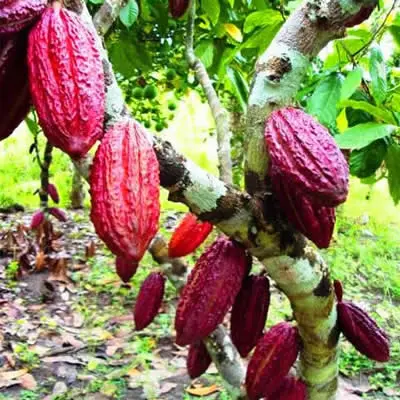Cacao (Theobroma Cacao), also known as Cocoa, originated in parts of Colombia, Brazil and Peru, but is now grown in many countries in South America, Africa, Asia and Mexico, virtually any place that is hot and rainy. Theobroma comes from the Greek “Theo” meaning “god” and “Broma” meaning “Food”, thus “food of the gods”. The use of cacao goes back several thousand years and the earliest uses as a beverage were found in Mexico. Cacao beans were also used as a form of currency due to their medicinal and aphrodisiacal properties. The first use of cacao goes back at least to 1400 BCE as cacao residue was found in pottery from that time period. The first European to encounter cacao was Christopher Columbus and the first discovery of its use as a beverage was by Hernán Cortés. Because of its bitterness, it did not become popular with Europeans until they discovered adding honey made it quite palatable.

There are a number of nutritional benefits of raw, organic cacao. It is very high in anti-oxidants, with the ORAC value being around 55,000, vs. 4,700 for blueberries, 9,000 for cranberries and 4,500 for pomegranate. It is the highest plant-based source of iron known. It is also very high in magnesium, which is an essential mineral that is deficient in a lot of diets.
Cacao trees are grown in equatorial regions in South America, Asia and Africa. They do best in warm climates with sufficient rain. The trees can grow up to 40’ tall, but farmers keep them cut back to aid in harvesting the pods. Since the tree is sensitive to sunlight, it does best as a shade tree, growing under the forest canopy. The cacao tree bears fruit year round, so there is a steady supply. The fruit (pods) vary quite a bit in color, size and shape. A ripe fruit can contain around 20 – 75 cacao beans.
Cacao products start with the harvesting of the cacao fruit or pod when they ripen to a red or orange color. The seeds (sometimes called beans) are embedded in a white pulp, on the inside of the pod. The pods are split open to reveal the pulp and beans which are then fermented together. The outer pod is discarded. During the fermentation process, the pulp “liquefies” and drains away, leaving the beans. This fermentation process eliminates a lot of bitterness from the beans. It takes about 200- 400 dried seeds to make 1 lb of chocolate. The seeds are then spread out and dried, either in the sun or in air dryers. Depending on the end use, the beans are then roasted. They are then cracked and deshelled, resulting in cacao nibs. The nibs are then ground into a thick paste known either as cacao paste or chocolate liquor. The paste is then put through a hydraulic press, which separates out the cacao butter. from the paste. What is left is called cacao mass or press cake and this is then ground into cacao powder.
Our cacao products are from Peru. Our partner in Peru works directly with over 5000 small farmers to whom they also provide technical expertise, training and financial support.
There is a big difference between cacao and what we know as cocoa and this is because of the way that they are processed. For both types of cocoa, the beans are first dried and fermented. After fermentation, the beans are deshelled and cracked into nibs. They are then heated at low temperatures to bring out the flavor. For conventional cocoa powder, as well as commercial chocolate bars, the beans are heated at much higher temperatures, which results in a slightly sweeter flavor. For Dutch-processed cocoa powder, there is an additional step of alkalizing. This makes the end product richer and less acidic. However, the high heat and alkalization also reduces the anti-oxidants and nutrients significantly.
Our cacao products are made from beans that are processed to raw standards. We use only the Criollo (“native” in Spanish) variety, which is more expensive and much higher quality than the Forastero variety (“foreigner” in Spanish), which is what is used in most commercial chocolate and is 80-90% of the cacao production. The other variety that comprises around 15-20% of total production is the Trinitario (from Trinidad) variety, which is used in high quality dark chocolates. The Criollo variety is much rarer and considered to have a more delicate flavor. Only about 5% of all cacao grown is of the Criollo variety.
In addition to being NOP organic and Kosher OU, our cacao products are also Fair Trade.


